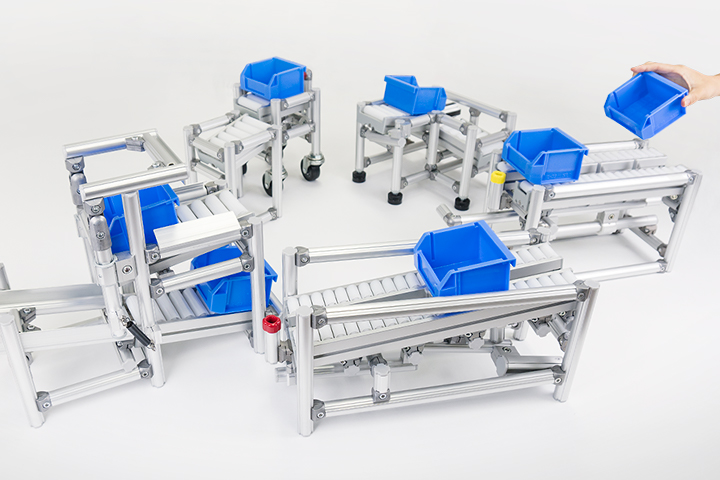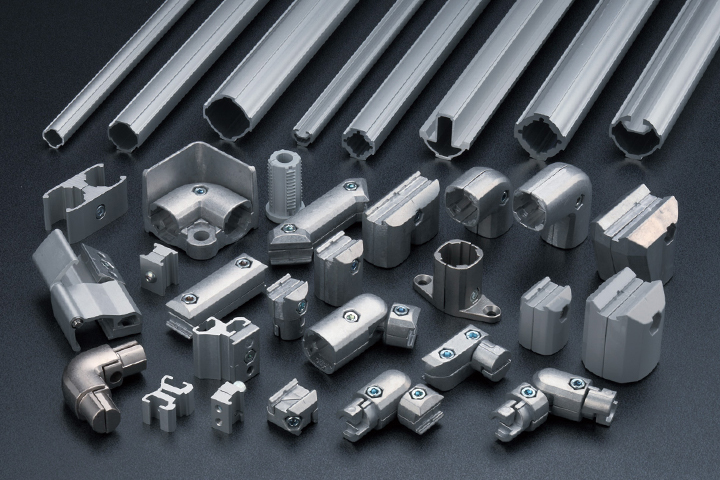- Introduction to Karakuri
- Basic Karakuri Units
- Karakuri Applications
- Ordering Karakuri Units
How Does Karakuri Work?
Working Smarter
SUS's Karakuri Mechanisms utilize gravity and the natural weight of items to achieve simple automation. Many tasks that once required an operator can now be unmanned. And because traditional karakuri mechanisms don't require electricity, operational costs are minimized for truly lean manufacturing.
Link Mechanism
The Link Mechanism consists of joints specially designed to be long lasting. Its ability to convert between circular motion and linear force makes it useful for a wide range of applications.
Movable Pulley
The Pulley System demonstrates the relationship between force and distance. By understanding the basic principles of pulleys, you can move items long distances or change the effort needed to move a load.
Karakuri Training

Simple Automation
Karakuri Training
Miniature karakuri are the perfect tool for learning lean automation. Easy to build, these kits teach how and why karakuri automation works. Each kit includes all parts, assembly instructions, and parts list.

Starter Package
Karakuri Training
Packages include all of the necessary frames, connectors, and motion parts to build full sized karakuri or standard structures. Drawings and parts lists are also included.
Turns
The corner table rotates 90 degrees and then returns to its original position via counterweight. The orientation of the tote is maintained.
The corner table tilts and then returns to its original position via counterweight. The orientation of the totes changes.
Stoppers
The intermittent stopper rotates, allowing the tote to move forward. Any subsequent totes would be held in place by the rear arm of the stopper.
Depressing the foot pedal activates the see-saw and releases the front tote while simultaneously holding back any subsequent totes.
These pages showcase 18 of SUS’s most popular Karakuri units in action. Many of the structures seen here are found in the Ready Solution Catalog.
To see dozens of additional videos, including assembly, tips, and new designs, visit SUS America on YouTube.
Flip-flop Chuter
Discharge Trolley
Horizontal Turn
AVG Dispense/Receive Trolley
Stopper (See-saw)
Elevator
Zig-zag Chuter
Flip-up Trolley
Palette Chuter
Elevator for Large Totes
Level Lifter (Spring)
Unstacker
Automated 90° Turn
Overpass Transfer
Electric Lifter
Automated Flip-flop Chuter
Electric Level Lifterr
Electric Transfer Table
How to Order Karakuri Units
SUS America offers two different ways to order karakuri units:Ready Solution Kits and Custom Structures.
Ready Solution Kits
14 different Karakuri units are available as shown in the Ready Solution Catalog, pages 60-66. These units arrive as ready-to-assemble kits in the dimensions listed below.
If you would like different dimensions to suit your unique tote size or space requirements, contact SUS America with your specifications to receive adjusted pricing and lead times.
Custom Structures
SUS provides services for both custom karakuri units and static structures. Contact SUS America with as much detail as possible about your goal and needs. A solutions representative will then get in touch with you to discuss your project. Below you can see the general process for designing, creating, and delivering a custom karakuri unit.

Contact SUS
Contact SUS via email, phone, or directly through our website. Let us know about you and the situation you'd like help with.
The more details you give us the more efficiently we can move towards a solution.

SUS Visits Your Site
After seeing the area you want to improve, SUS will sit down with you to discuss possible solutions and build your company profile.
This ensures fast, accurate service throughout the process.

Receive a Sketch and Estimate
Depending on the complexity of your situation, you will receive a sketch and estimate after a few days or a few weeks.
This will include the lead time, assembly options, and purchasing preferences.

Make adjustments
Discuss the sketch and estimate with your team to see if there are any features that need adjustment.
If you'd like, SUS can visit your site again to talk about alterations and further options.

Send in a Purchase Order
Once we receive your purchase order, SUS processes your request and begins working on your structure.

Cutting and Assembly
Frames and connectors are prepared to millimeter precision and assembled by expert technicians, or packed into a ready-to-assemble kit.

Shipping
The structure is carefully packaged and shipped to your location according to your instructions.

Check-up
SUS visits your site again to discuss any additional adjustments and continued improvements.